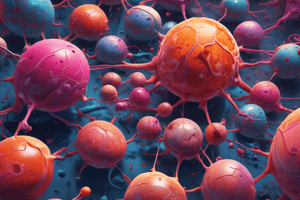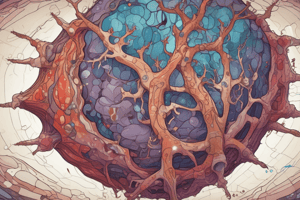Podcast
Questions and Answers
What are the two microscopic patterns of reversible injury?
What are the two microscopic patterns of reversible injury?
- Cellular swelling and fatty change (correct)
- Mitochondrial swelling and nuclear alterations
- Cellular swelling and mitochondrial swelling
- Fatty change and nuclear alterations
What may result in cellular swelling?
What may result in cellular swelling?
- Chemical poisoning and mitochondrial swelling
- Hypoxia and nuclear alterations
- Chemical poisoning and hypoxia (correct)
- Fatty change and mitochondrial swelling
What are the intracellular changes associated with reversible injury?
What are the intracellular changes associated with reversible injury?
- Plasma membrane blebbing, mitochondrial swelling, and endoplasmic reticulum dilation (correct)
- Mitochondrial swelling, nuclear alterations, and fatty change
- Nuclear alterations, fatty change, and mitochondrial swelling
- Plasma membrane blebbing, mitochondrial swelling, and nuclear alterations
Under what conditions may the changes of reversible injury become irreversible?
Under what conditions may the changes of reversible injury become irreversible?
What are the gross microscopic changes associated with reversible injury?
What are the gross microscopic changes associated with reversible injury?
What is the earliest change observed in injured cells under reversible injury?
What is the earliest change observed in injured cells under reversible injury?
Which process is responsible for the release of fatty acids and calcium in acute pancreatitis?
Which process is responsible for the release of fatty acids and calcium in acute pancreatitis?
Which type of necrosis is characterized by leakage of plasma into the media and fibrin deposition in the damaged vessel wall?
Which type of necrosis is characterized by leakage of plasma into the media and fibrin deposition in the damaged vessel wall?
What is the fate of most necrotic tissue when it is removed by leukocytes combined with extracellular enzyme digestion?
What is the fate of most necrotic tissue when it is removed by leukocytes combined with extracellular enzyme digestion?
Which clinical condition is associated with leakage of contractile protein troponin due to tissue damage?
Which clinical condition is associated with leakage of contractile protein troponin due to tissue damage?
What is the process that leads to the formation of fatty saponification in acute pancreatitis?
What is the process that leads to the formation of fatty saponification in acute pancreatitis?
Which type of necrosis involves the histological appearance of smooth muscle necrosis in arterioles due to vasculitis and hypertension?
Which type of necrosis involves the histological appearance of smooth muscle necrosis in arterioles due to vasculitis and hypertension?
Which cell injury pattern is characteristic of tuberculous infection?
Which cell injury pattern is characteristic of tuberculous infection?
What is the most common form of necrosis, particularly in the myocardium, liver, and kidney?
What is the most common form of necrosis, particularly in the myocardium, liver, and kidney?
Which type of necrosis involves complete digestion of dead cells with rapid dissolution, often seen in bacterial and fungal infections?
Which type of necrosis involves complete digestion of dead cells with rapid dissolution, often seen in bacterial and fungal infections?
Which form of necrosis refers to ischemic coagulative necrosis with superimposed infection and putrefaction of tissue?
Which form of necrosis refers to ischemic coagulative necrosis with superimposed infection and putrefaction of tissue?
What causes focal areas of fat destruction, resulting in white, chalky areas?
What causes focal areas of fat destruction, resulting in white, chalky areas?
What is the mechanism underlying coagulative necrosis?
What is the mechanism underlying coagulative necrosis?
Which type of cell death involves the characteristic accumulation of white blood cells, seen in bacterial and some fungal infections?
Which type of cell death involves the characteristic accumulation of white blood cells, seen in bacterial and some fungal infections?
In which part of the body is dry gangrene usually seen as a result of arterial obstruction?
In which part of the body is dry gangrene usually seen as a result of arterial obstruction?
Flashcards
Cellular Swelling
Cellular Swelling
Occurs when there's an influx of sodium and impaired ion pumps, leading to cell swelling.
Intracellular Changes in Reversible Injury
Intracellular Changes in Reversible Injury
An early sign of reversible injury characterized by mitochondrial swelling, ATP depletion, and cytoplasmic swelling. It can also include loss of microvilli and chromatin clumping.
Irreversible Injury
Irreversible Injury
Occurs when significant ATP depletion and loss of membrane integrity happen, leading to cell death.
Gross Microscopic Changes in Reversible Injury
Gross Microscopic Changes in Reversible Injury
Signup and view all the flashcards
Earliest Change in Injured Cells
Earliest Change in Injured Cells
Signup and view all the flashcards
Process in Acute Pancreatitis
Process in Acute Pancreatitis
Signup and view all the flashcards
Fibrinoid Necrosis
Fibrinoid Necrosis
Signup and view all the flashcards
Fate of Necrotic Tissue
Fate of Necrotic Tissue
Signup and view all the flashcards
Troponin Leakage
Troponin Leakage
Signup and view all the flashcards
Formation of Fatty Saponification
Formation of Fatty Saponification
Signup and view all the flashcards
Fibrinoid Necrosis in Vasculitis
Fibrinoid Necrosis in Vasculitis
Signup and view all the flashcards
Caseous Necrosis in Tuberculosis
Caseous Necrosis in Tuberculosis
Signup and view all the flashcards
Coagulative Necrosis
Coagulative Necrosis
Signup and view all the flashcards
Liquefactive Necrosis
Liquefactive Necrosis
Signup and view all the flashcards
Gas Gangrene
Gas Gangrene
Signup and view all the flashcards
Fat Destruction in Acute Pancreatitis
Fat Destruction in Acute Pancreatitis
Signup and view all the flashcards
Mechanism Underlying Coagulative Necrosis
Mechanism Underlying Coagulative Necrosis
Signup and view all the flashcards
Neutrophilic Infiltration in Necrosis
Neutrophilic Infiltration in Necrosis
Signup and view all the flashcards
Location of Dry Gangrene
Location of Dry Gangrene
Signup and view all the flashcards
Study Notes
Microscopic Patterns of Reversible Injury
- Two microscopic patterns include cellular swelling and fatty change.
- Cellular swelling occurs due to sodium entry and impaired ion pumps.
Intracellular Changes in Reversible Injury
- Reversible injury leads to early changes such as mitochondrial swelling, ATP depletion, and cytoplasmic swelling.
- Loss of microvilli and chromatin clumping can also be observed.
Transition to Irreversible Injury
- Changes of reversible injury become irreversible when significant ATP depletion and loss of membrane integrity occur, leading to necrosis.
Gross Microscopic Changes in Reversible Injury
- Observable changes include edema, cellular swelling, and reorganization of cellular structures.
Earliest Change in Injured Cells
- The earliest change seen in injured cells is cellular swelling, often indicating a shift in ion homeostasis.
Process in Acute Pancreatitis
- The release of fatty acids and calcium in acute pancreatitis is due to the process of enzymatic digestion of pancreatic tissue.
Type of Necrosis with Plasma Leakage
- Fibrinoid necrosis is characterized by plasma leakage into the media and fibrin deposition in damaged vessel walls.
Fate of Necrotic Tissue
- Most necrotic tissue is removed by leukocytes through a combination of phagocytosis and extracellular enzyme digestion.
Clinical Condition and Troponin Leakage
- Troponin leakage is commonly associated with myocardial infarction due to cell damage in cardiac tissue.
Formation of Fatty Saponification
- Fatty saponification in acute pancreatitis occurs due to the interaction of released fatty acids with calcium ions, resulting in chalky deposits.
Type of Necrosis in Vasculitis
- Fibrinoid necrosis is also observed in smooth muscle necrosis in arterioles due to conditions like vasculitis and hypertension.
Characteristic Cell Injury Pattern in Tuberculosis
- Caseous necrosis is characteristic of tuberculosis infections, showing cheese-like (caseous) appearance in tissue.
Most Common Form of Necrosis
- Coagulative necrosis is the most common form, particularly affecting the myocardium, liver, and kidney.
Type of Necrosis in Bacterial Infections
- Liquefactive necrosis involves complete digestion of dead cells with rapid dissolution, often associated with bacterial and fungal infections.
Ischemic Coagulative Necrosis
- Gas gangrene refers to ischemic coagulative necrosis with superimposed infection and tissue putrefaction.
Mechanism of Fat Destruction
- Focal areas of fat destruction, producing white, chalky areas, are caused by enzymatic action during acute pancreatitis.
Mechanism Underlying Coagulative Necrosis
- Coagulative necrosis is caused by reduced blood flow leading to the preservation of cellular outlines while the internal structure undergoes breakdown.
Cell Death with White Blood Cell Accumulation
- Neutrophilic infiltration leading to tissue damage is characteristic of necrosis associated with bacterial infections.
Location of Dry Gangrene
- Dry gangrene is typically seen in the extremities, often resulting from arterial obstruction.
Studying That Suits You
Use AI to generate personalized quizzes and flashcards to suit your learning preferences.
Related Documents
Description
Explore the sequence of events in cell injury and cell death, including patterns of acute cell injury and reversible injury such as cellular swelling and fatty change. Understand the microscopic patterns of reversible injury and the causes of cellular swelling.






